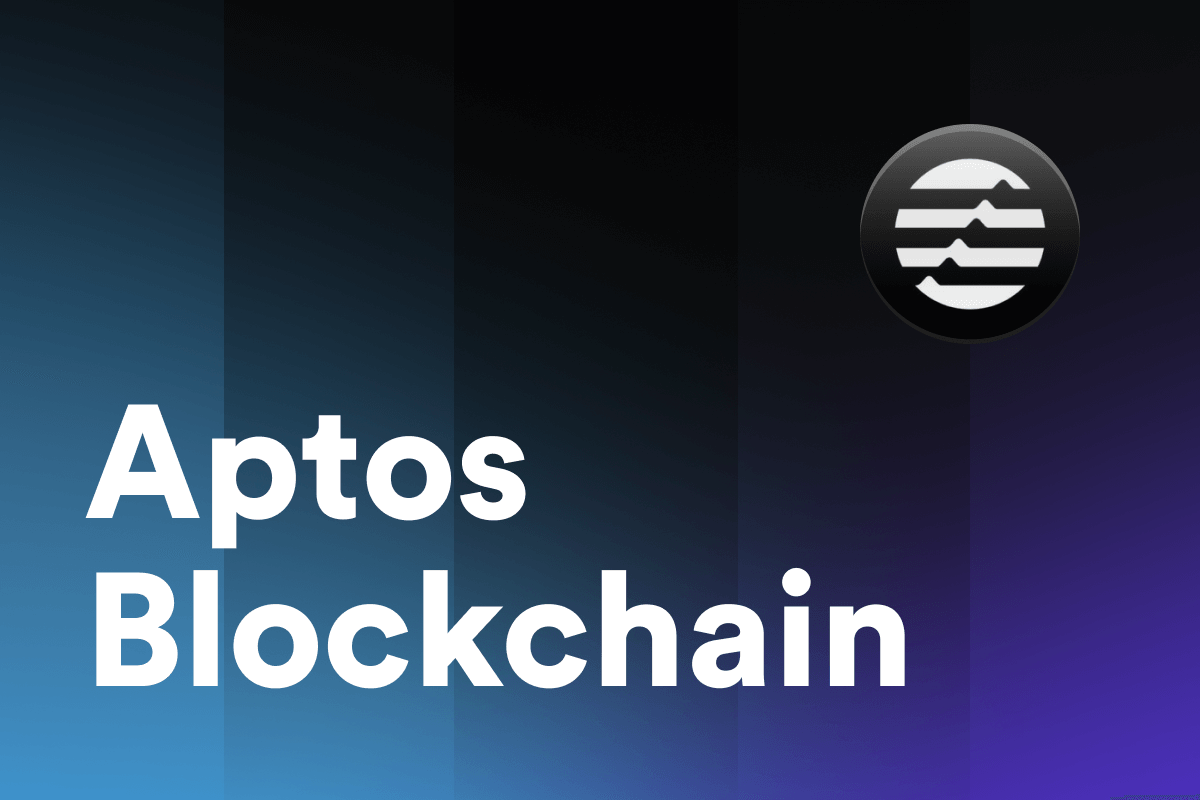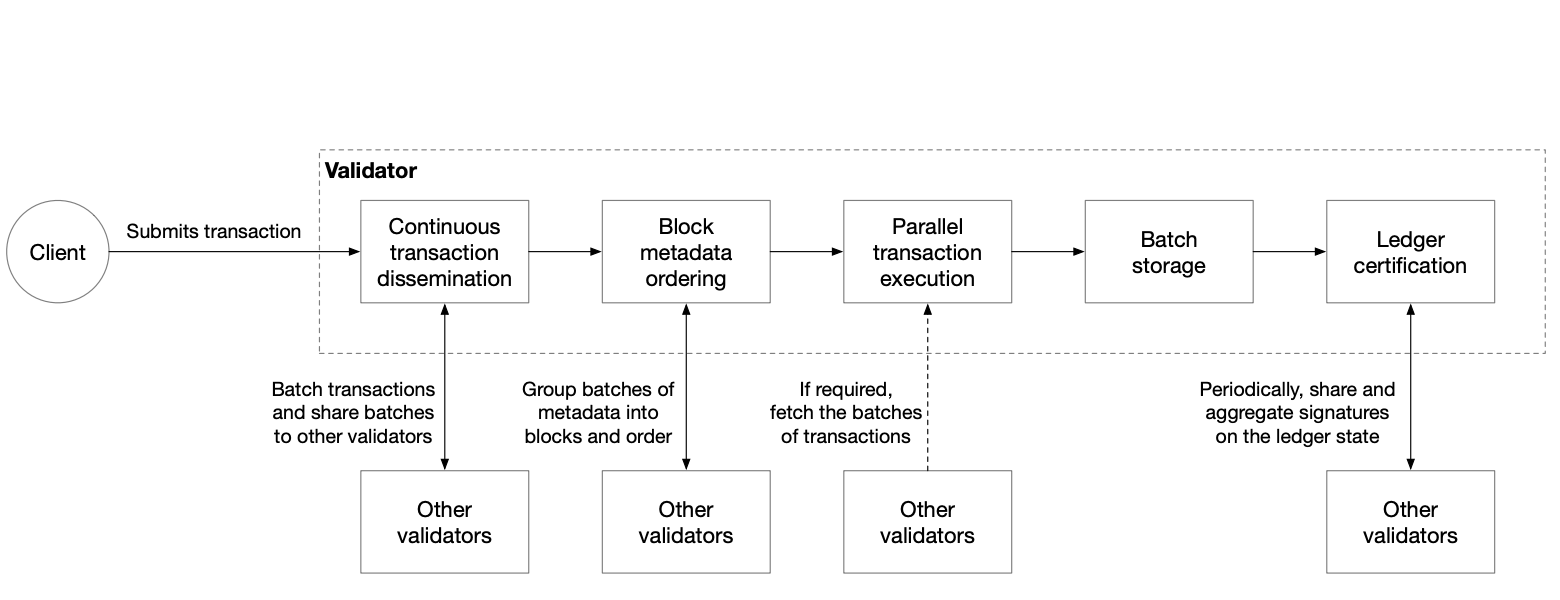
What Is Aptos?
Aptos is a Layer 1, modular blockchain platform focused on scalability, security, and efficient transaction processing. It uses a proof-of-stake mechanism to offer a user-friendly blockchain experience, catering to decentralized applications and smart contracts. Notably, Aptos, with its modular design, is engineered to deliver superior performance and reliability, making it an appealing choice for a diverse range of blockchain applications. This platform is increasingly recognized for its potential to revolutionize blockchain services and technologies, leveraging its modular architecture to adapt and evolve in the rapidly changing blockchain landscape.
What Is Modular Blockchain?
A modular blockchain is a design where different components of the blockchain—such as consensus, data storage, and transaction execution — are separated into distinct modules. This architecture allows for more targeted improvements and updates in each area, enhancing overall efficiency and adaptability. In the case of Aptos, its modular nature facilitates easier upgrades and customization, ensuring that the platform can swiftly adapt to new technologies and user needs.
 The transaction processing life cycle in Aptos. All stages are completely independent and are individually parallelizable. Source: aptosfoundation.org
The transaction processing life cycle in Aptos. All stages are completely independent and are individually parallelizable. Source: aptosfoundation.org
Differences Between Aptos and Other Blockchains
Aptos stands out in the blockchain world due to several unique features. Unlike many blockchains, Aptos emphasizes a high level of scalability, efficiently managing a vast number of transactions. This is achieved through its advanced consensus protocol AptosBFT. Additionally, Aptos is designed with a focus on enhancing developer experience, providing user-friendly tools and resources that streamline the development of decentralized applications. Security is another key difference, as Aptos incorporates innovative measures to ensure robust protection against various threats. These aspects collectively make Aptos a noteworthy contender in the evolving landscape of blockchain technology.
Differences Between Aptos and Celestia
Aptos and Celestia, while sharing the common goal of enhancing blockchain scalability and efficiency, exhibit significant differences in their technical approaches, design choices, and areas of focus. Aptos employs the Move language, specifically crafted for secure blockchain transactions, to improve both the developer experience and security. This contrasts with Celestia, which does not mandate a specific smart contract language, thus offering greater development flexibility. Celestia’s key innovation is its “data availability” layer, which decouples data availability from transaction execution, introducing more versatility in the construction and interaction of blockchains.
Consensus Protocol AptosBFT
The consensus protocol used in Aptos, known as AptosBFT, is a distinctive aspect of its architecture, setting it apart from many other blockchain platforms. This protocol is a variant of the Byzantine Fault Tolerance (BFT) consensus model, designed to offer high transaction throughput, scalability, and robust security.
Key Features of AptosBFT
-
High Throughput and Scalability: AptosBFT is engineered to efficiently handle a large volume of transactions, enhancing the blockchain’s overall scalability.
-
Security: Leveraging the strengths of the BFT model, AptosBFT maintains network integrity and security, even in the presence of malicious or compromised nodes.
-
Energy Efficiency: Unlike proof-of-work (PoW) systems, BFT-based systems like AptosBFT require less computational power, making them more sustainable and energy-efficient.
-
Finality: Transactions achieve quick finality in the AptosBFT model, ensuring that once confirmed, they are unlikely to be reversed, thus providing reliability and certainty.
-
Decentralization and Participation: Aptos emphasizes decentralization, with its consensus mechanism allowing diverse validators to participate, enhancing network security and robustness.
The AptosBFT consensus protocol is a core component of the Aptos blockchain, significantly contributing to its performance, security, and efficiency. It reflects the platform’s focus on creating a scalable, secure, and developer-friendly blockchain environment.
Why Developers and Users Choose Aptos
-
Firstly, Aptos blockchain inherently uses the Move language, designed for swift and secure transaction processing. The Move prover, a tool for checking smart contracts in Move, adds extra security layers, ensuring contracts behave as intended. This enhances security, helping developers safeguard their software against threats.
-
Second, Aptos offers a flexible data model for managing keys and hybrid custody. Users benefit from transparent transactions and efficient light client protocols, leading to a safer, more reliable experience.
-
Third, Aptos achieves fast processing and low delay by using a pipelined, modular method for transaction steps. Activities like transaction spread, block ordering, parallel execution, and certification happen simultaneously, maximizing hardware use and enabling parallel processing.
-
Fourth, unlike some parallel systems that limit transaction complexity, Aptos maintains full transaction atomicity without such restrictions. This supports complex transactions efficiently, leading to faster processing and easier development.
-
Fifth, Aptos’ design is modular, enhancing client adaptability and allowing quick updates. It also includes on-chain protocols for fast deployment of new technologies and supporting emerging web3 scenarios.
-
Finally, Aptos is exploring ways to scale beyond single validator limits. Its design and parallel engine allow for internal validator sharding, and its state sharding could increase throughput without extra complexity for node operators.
 Aptos User Transactions for November 2023. Source: aptoslabs.com
Aptos User Transactions for November 2023. Source: aptoslabs.com
APT: The Lifeblood of the Aptos Network
The Aptos token, commonly referred to as APT, serves as the native currency of the Aptos blockchain. It is primarily utilized for covering network-related expenses and transaction fees within the Aptos ecosystem.
Tokenomics of APT
-
Initial Total Supply: 1 billion tokens at mainnet launch.
-
Staking Rewards: Initial maximum reward rate of 7% annually, decreasing to 3.25% over time.
-
Transaction Fee Burn:
- Transaction fees are currently burned, reducing overall token supply.
- This policy may change with future on-chain governance.
Uses of APT
-
Transaction Fees: APT is used for transaction fees within the Aptos network. Fees apply to various transactions, including transfers from your Aptos wallet and withdrawals from exchanges, executing smart contracts, and transferring NFTs. These fees are integral to the network’s operations, ensuring transaction processing and network security.
-
Staking in Proof-of-Stake: Aptos uses a proof-of-stake mechanism, where stakers secure the network and earn rewards using APT. As of 2023, there were 121 validators on the network with over 892,425,972 APT staked. This system plays a crucial role in maintaining network security and distributing rewards to participants.
-
Governance: APT enables community voting on proposals in the Aptos governance system.
-
Payment Services: APT is utilized in payment services on Aptos-based apps. APT is easily acquired through exchanges by swapping or directly purchasing with a credit card via the Gem Wallet app, enhancing its accessibility in the Aptos ecosystem.
-
NFT: APT tokens are also essential for NFT enthusiasts, whether it’s for minting new collections or purchasing already popular NFTs.


